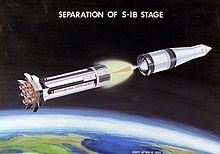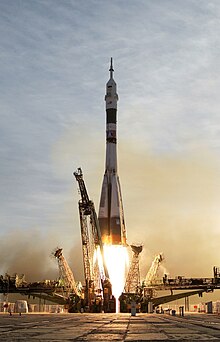Rocket launch
The rocket launch is the first phase of a rocket's flight. While rocket launches for sounding rockets or fireworks do not require a lot of preparation and for short-range military rockets are essentially limited to precise alignment, lengthy tests and calculations must precede them in space travel . This is related to
- Aspects of safety, because launchers for satellites or spaceships have a very large launch mass and highly explosive fuels,
- the high cost of the payload , which i. A. is lost,
- the even higher security precautions of manned space travel .
Less elaborate launch preparations, but similar control technology require far-reaching missile weapons such as medium and long-range missiles - see there.
Rocket launch principle
Missiles work on the principle of recoil , i. H. by the expulsion of hot gases that are formed from the fuel and the oxidizing agent after ignition and escape under high pressure through the Laval nozzle in the rocket base. In contrast to aerodynamic missiles, a rocket works independently of the gases in the earth's atmosphere , but is influenced by their resistance when they penetrate . This depends on the speed, the shape of the rocket and the increasing air density , its effect also on the rocket mass.
The thrust of a rocket must be greater than the launch weight; the greater the difference, the faster the rocket gains speed. The thrust depends on the speed of the propellant gases emitted (usually around 2 to 4.5 km / s) and their throughput (mass per time). The achievable difference in speed of each rocket stage depends on the logarithm of the mass ratio of the rocket (launch mass to end-of-fire mass ) and the ejection speed (see: Basic rocket equation ).
Rocket launches in space travel
Start preparations (simplified)
A rocket suitable for space travel has thousands of individual components, on the reliability of which the success of a rocket launch depends. In addition to the purely technical drive units and pumps of the rocket motor, the refueling of the fuel and oxygen tanks, the holding device on the launch pad , etc. there are numerous radio and measuring instruments , the gyro stabilization necessary for precise control and much more. All of these systems must be monitored until they are started (and afterwards) so that the start can be aborted if they fail. The countdown , which begins a few days before the start and becomes increasingly intense over the last few hours, is used for this purpose .
The most important subtasks before the rocket launch and in the countdown are:
- Advance calculation of the best launch window - ie the period in which the spatial position of the rocket base in relation to the planned orbit is as energetically favorable as possible (e.g. for the orbit inclination and perigee , extensive use of the earth's rotation ). It gets even more complicated with interplanetary flights: Here the mutual position of the earth and the planet has to be included in the calculation, the time of day, the possible proximity of the moon or other celestial bodies etc. If the start is delayed by a few days, “that Close start window ".
- Weather forecast - depending on the type of missile, heavy cloud cover, precipitation, winds or thunderstorms can endanger a launch. For short space flights, the weather situation must also be suitable for the time of return and landing .
- Adjustment of fuel and other supplies to the expected take-off and flight conditions
- gentle transport of the launcher to the launch pad
- Attachment to the holding device (starting frame)
- Checking the payload capsule, making all connections
- Start of the countdown: Continuous technical control of all rocket parts, the launch pad, etc.
- Control of energy and security systems
- Beginning and ongoing control of refueling
- Ongoing leakage , vibration and temperature tests of various kinds
- ongoing review of radio, telemetry , measuring and navigation instruments
- possibly loading of the capsule with sensitive or perishable material (test materials, living beings)
- If necessary, entry of the spacemen and start of their checks
- Run-up of the rocket units (pumps, etc.) and auxiliary units
- Swiveling away the holding device
- Ignition and final check of the rocket motors (thrust control)
Starting sequence
The burn time of the individual rocket stages used in space travel is a few minutes. At the beginning, the aerodynamic load on the rocket structure increases with increasing speed. The point at which this load is maximum, is Max Q called. As the flight progresses, the aerodynamic load decreases again because the air pressure in the higher layers of the atmosphere decreases.
For this reason, rockets first start vertically upwards and then gradually change into a horizontal flight. Reaching the necessary horizontal speed of around 7.8 km / s for a low orbit makes up by far the largest share of the energy requirement. A flight into space on a suborbital orbit can be achieved with significantly less effort.
A typical three-stage rocket uses the first stage mainly to gain altitude so that it can get into thinner layers of air relatively quickly. At the same time, a large part of the gravitational losses is reduced in this phase . With the continuous inclination to the horizontal, speed is also built up for the orbit. When the first stage burns out, the rocket is so high that air resistance is almost irrelevant. The second stage then accelerates the remaining and significantly lighter rocket almost to the necessary orbital speed. This is then achieved with the third stage; however, the last stage can often be ignited several times in order to be able to make further corrections to the orbit.
If the final speed is above 7.8 km / s, the satellite moves further away from the earth on an elliptical orbit until it reaches its higher apogee on the opposite side . Even with a 1% excess (which was a common tolerance at the beginning of space travel) the apogee is around 300 km higher than the point of entry into the orbit.
To reach another celestial body, at least the second cosmic speed is required ( v 2 ), which is 200 km above the earth at about 11 km / s.
For orbits with little inclination to the equator, it is advantageous if the rocket launch takes place as close as possible to the equator and in an easterly direction, because then the speed advantage due to the earth's rotation is greatest at 465 m / s and the Eötvös effect results in an advantage of gravity.
Advantage of step missiles

Final speeds of well over 4 km / s per stage are difficult to achieve with conventional fuels , but these speeds can be added up with stage rockets . Here, the second step sits on top of the first and illustrates its payload after the burnout of the lower stage and the shedding, the Acceleration continues in flight at a significantly lower total mass. Similarly, a third stage can represent the payload of the second stage. In rare cases, a fourth stage can even be used.
The top rocket stage carries the payload - the earth satellite (s) to be launched , the interplanetary space probe or the capsule with the crew. Once the payload has reached its planned final speed, it is separated from the rocket stage; afterwards both fly on almost identical orbits, but the burnt-out rocket shell is slowed down more by the particles of the high atmosphere than the payload equipped with its own engine, so that it enters a lower orbit and "overtakes" the latter from below and, after some time, in the lower one Atmosphere fades away. The orbit of the payload, on the other hand, is precisely measured (see orbit determination and parking orbit) and - if it has control rockets - it is brought precisely to the planned orbit or on a transition path to another celestial body through targeted small orbit maneuvers .
For the material and technical processes involved in the design, construction and operation of rockets, see rocket technology .
statistics
Since the beginning of the 21st century, around 55–115 rocket launches have taken place annually to bring payloads into stable orbit or beyond (2019: 97 successful, 102 in total). During the Cold War , the number of these rocket launches was higher.
See also
Individual evidence
- ^ Ed Kyle: Worldwide Orbital Launch Summary by Year. In: Space Launch Report. December 31, 2019, accessed January 19, 2020 .


